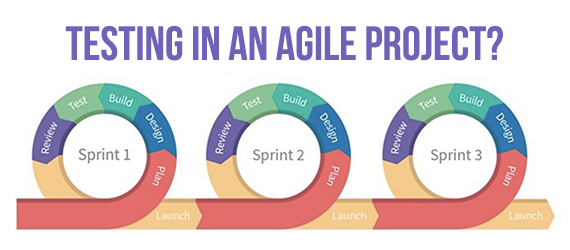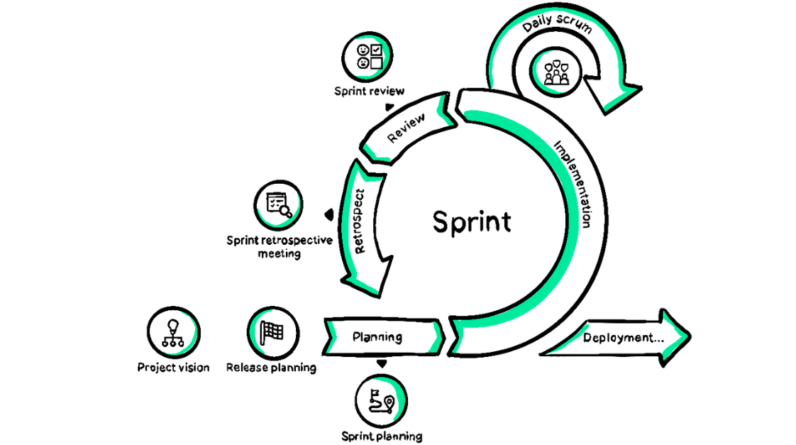
So you’ve heard the term “sprint” being thrown around in the realm of project management, but you’re not quite sure what it means. Well, fear not, because this article is here to demystify the concept for you. A sprint in project management refers to a time-boxed period, typically ranging from one to four weeks, during which a team works on a set of tasks to achieve specific goals. It’s a focused and intense burst of activity that allows teams to drive their projects forward efficiently and effectively. In this article, we’ll explore the key aspects of sprints and uncover how they can enhance project outcomes. Get ready to sprint your way to success!
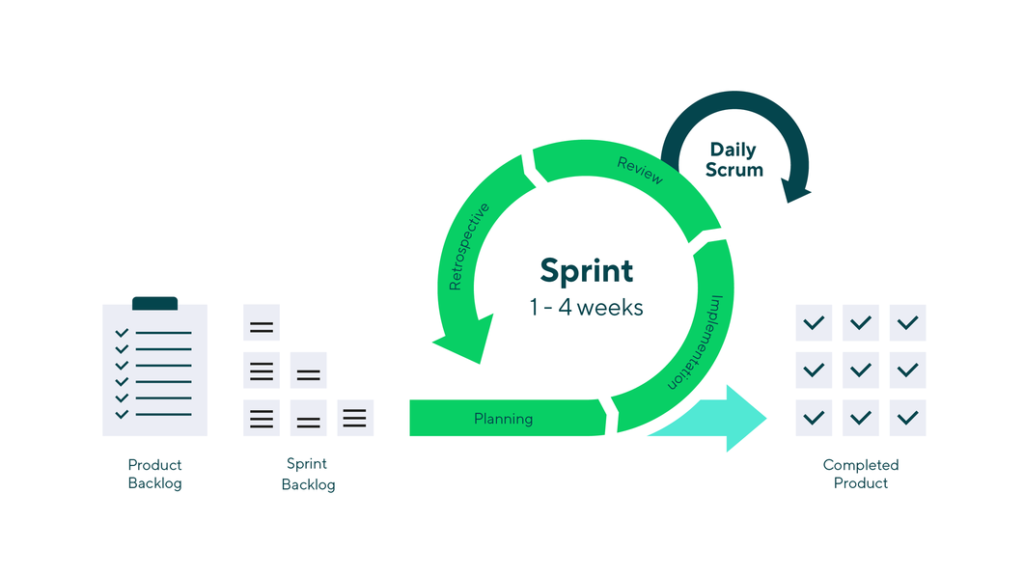
What is a Sprint in Project Management
Definition of a Sprint
A sprint in project management is a time-boxed period of work in which a team collaborates to complete a set of tasks and deliverables. It is often used in agile project management methodologies, such as Scrum or Kanban, to enable iterative and incremental development. The duration of a sprint is typically short, ranging from one to four weeks, and remains consistent throughout the project. During a sprint, the team focuses on delivering a specific goal, known as the sprint goal, by the end of the time period.
Purpose of Sprint in Project Management
The main purpose of a sprint in project management is to promote a predictable and iterative approach to project execution. By breaking down the project into smaller, manageable chunks, sprints allow the team to focus on delivering tangible outcomes within a fixed timeframe. This helps to manage project scope, control risks, and ensure regular feedback from stakeholders. Sprints also foster collaboration, transparency, and adaptability, as team members work together closely and continuously improve their processes and deliverables.
Key Components of a Sprint
A sprint in project management typically consists of several key components that contribute to its success. These include:
-
Sprint Planning: This initial phase involves defining the sprint goal and determining the scope of work to be accomplished. The team collaborates to prioritize tasks and establish a sprint backlog, which contains a list of specific items to be completed during the sprint.
-
Execution and Daily Activities: During the sprint, the team works on the tasks identified in the sprint backlog. Daily stand-up meetings are held to provide updates on progress, discuss any impediments, and ensure alignment across team members.
-
Sprint Review and Retrospective: Once the sprint is completed, a sprint review is conducted to showcase the deliverables to stakeholders and gather their feedback. This is followed by a sprint retrospective, where the team reflects on their performance, identifies areas for improvement, and makes necessary adjustments for future sprints.
-
Managing Changes: While sprints aim to maintain a fixed scope, it is common for changes to arise during the project. Therefore, effective change management practices should be in place to address any modifications in requirements or scope that may impact the sprint progress.
-
Sprint Metrics and Reporting: Tracking sprint progress through relevant metrics is crucial to measure performance and identify opportunities for enhancement. Sprint reports are generated to provide stakeholders with information on completed tasks, remaining work, and overall sprint performance.
Role of Sprint in Agile Project Management
In the context of agile project management, the sprint plays a significant role in ensuring successful project execution. Agile methodologies, such as Scrum or Kanban, emphasize iterative development and collaboration, and sprints form the foundation of these approaches. Sprints enable teams to work in short cycles, delivering working increments of the project at regular intervals. This facilitates frequent feedback and adaptation, allowing the project to respond to changing requirements or market conditions effectively. Additionally, sprints promote transparency and visibility, as progress and issues are visible to all stakeholders throughout the project lifecycle.
Understanding Sprint Planning
Importance of Sprint Planning
Sprint planning is a critical phase in project management as it sets the stage for a successful sprint. During sprint planning, the team collaborates to define the sprint goal, identify the scope of work, and prioritize tasks. This process allows the team to align their efforts towards achieving the sprint goal and ensures that everyone has a clear understanding of the objectives and expectations. Sprint planning also helps in estimating the effort required for each task, enabling the team to assess the feasibility of completing the work within the sprint’s timeframe.
Steps Involved in Sprint Planning
Sprint planning typically involves the following steps:
-
Define the Sprint Goal: The team collectively defines the sprint goal, which represents the purpose or outcome the team aims to achieve by the end of the sprint. The sprint goal provides focus and direction to the team during the sprint.
-
Groom the Product Backlog: The product backlog contains a prioritized list of all the requirements or user stories for the project. In sprint planning, the team reviews the product backlog, adds new items if necessary, and refines the existing ones to ensure they are well-defined and ready for implementation.
-
Select User Stories for the Sprint: Based on the sprint goal and the priority of the user stories in the product backlog, the team selects a subset of user stories to be included in the sprint. These user stories are then further broken down into smaller, manageable tasks.
-
Estimate Effort and Capacity: The team estimates the effort required for each task and considers the team’s capacity or availability to determine how many tasks can be taken up in the sprint. This helps in balancing workload and prioritizing tasks for the sprint backlog.
-
Create the Sprint Backlog: The sprint backlog is created, which consists of the selected user stories and the corresponding tasks that the team commits to completing within the sprint. The sprint backlog serves as a roadmap for the sprint, guiding the team’s work towards accomplishing the sprint goal.
Execution and Daily Activities during Sprint
Execution of a Sprint
Once the sprint planning is complete and the sprint backlog is established, the team enters the execution phase of the sprint. During this time, team members actively work on the tasks identified in the sprint backlog, aiming to complete them by the end of the sprint. Continuous collaboration, effective communication, and efficient task management are key aspects of sprint execution.
To ensure a smooth execution, the team should:
-
Collaborate: Team members collaborate closely, working together to complete their tasks and achieve the sprint goal. Regular communication and coordination are essential to address any dependencies or roadblocks that may arise.
-
Track Progress: The team should track their progress regularly, monitoring the completion of tasks and identifying any deviations from the planned schedule or effort estimates. This allows for timely adjustments and keeps the team on track towards achieving the sprint goal.
-
Manage Tasks: Managing tasks effectively involves breaking down user stories into smaller, actionable tasks and assigning them to team members. Task boards or digital tools can be used to visualize and track the progress of each task.
Daily Stand-up Meetings
During a sprint, daily stand-up meetings are conducted to facilitate communication and coordination within the team. These meetings, also known as daily scrums, are typically time-boxed to a maximum of 15 minutes and aim to provide a quick update on the progress and status of each team member. The key objectives of daily stand-up meetings include:
-
Sharing Updates: Each team member shares what they worked on yesterday, what they plan to work on today, and any obstacles or challenges they are facing. This promotes transparency and keeps everyone informed about the progress of the sprint.
-
Identifying and Addressing Impediments: Stand-up meetings offer an opportunity for team members to raise any issues or impediments they are encountering. By discussing these challenges openly, the team can collaboratively find solutions, remove obstacles, and ensure the sprint progresses smoothly.
-
Ensuring Alignment: Daily stand-up meetings help the team to align their efforts and identify any dependencies or bottlenecks that may impact the sprint’s progress. This fosters a sense of shared responsibility and encourages collaboration among team members.
Monitoring and Controlling Activities
Monitoring and controlling activities are essential throughout the sprint to ensure that the project stays on track and meets its goals. Key actions in monitoring and controlling during a sprint may include:
-
Regular Progress Updates: The team should track the completion of tasks, compare it with the planned schedule, and identify any deviations. Regular updates on progress help the team assess their performance and make necessary adjustments to meet the sprint goal.
-
Addressing Risks and Issues: Any risks or issues that arise during the sprint should be promptly identified and managed. Proactive risk mitigation strategies and issue resolution can help minimize their impact on the sprint progress.
-
Managing Change Requests: If there are changes or new requirements that emerge during the sprint, they should be assessed for their impact on the sprint goal and prioritized accordingly. Effective change management practices ensure that changes are evaluated properly and incorporated into the sprint without disrupting its progress.
-
Collaborative Problem-Solving: Throughout the sprint, collaboration and teamwork are essential for resolving any challenges or obstacles that may impede progress. Team members should work together to find innovative solutions and overcome any roadblocks, promoting a collaborative and supportive sprint environment.
Sprint Review and Retrospective
Purpose of Sprint Review
The sprint review is a significant event that occurs at the end of each sprint. Its purpose is to present the completed deliverables to stakeholders and gather their feedback. The sprint review provides an opportunity for stakeholders to assess the progress made during the sprint and ensure that the project aligns with their expectations. Additionally, the sprint review helps the team receive valuable insights and suggestions from stakeholders, which can guide future sprint planning and implementation.
Key Activities in Sprint Review
The sprint review typically involves the following key activities:
-
Demonstrate Deliverables: The team showcases the completed deliverables, such as working features or functionalities, to the stakeholders. This demonstration allows stakeholders to visualize the progress made and provides an opportunity for them to provide feedback.
-
Gather Feedback: Stakeholders provide feedback and suggestions based on the demonstrated deliverables. This feedback helps the team understand the stakeholders’ perspectives, validate the work done, and make any necessary adjustments for future sprints or iterations.
-
Update Product Backlog: The input received from stakeholders during the sprint review may lead to updates in the product backlog. Any new requirements, changes, or priorities identified are incorporated into the product backlog, ensuring that it remains aligned with the evolving needs of the project.
Importance of Sprint Retrospective
The sprint retrospective is a meeting that follows the sprint review and focuses on the team’s performance and process improvement. It is a crucial element of agile project management as it allows the team to reflect on their experiences, identify areas for improvement, and implement changes that enhance future sprints. The key benefits of a sprint retrospective include:
-
Continuous Improvement: By reflecting on their performance and identifying areas of improvement, the team can foster a culture of continuous learning and enhancement. Through retrospective discussions, the team can adapt their processes, address any bottlenecks, and optimize their productivity in subsequent sprints.
-
Team Collaboration: The retrospective provides a platform for team members to openly share their experiences, challenges, and ideas. It encourages collaboration and teamwork, as team members work together to find practical solutions and optimize their working practices.
-
Empowerment and Ownership: The retrospective empowers team members to have a voice in shaping their processes and project execution. It reinforces a sense of ownership and responsibility, as team members actively contribute to the improvement of their work environment.
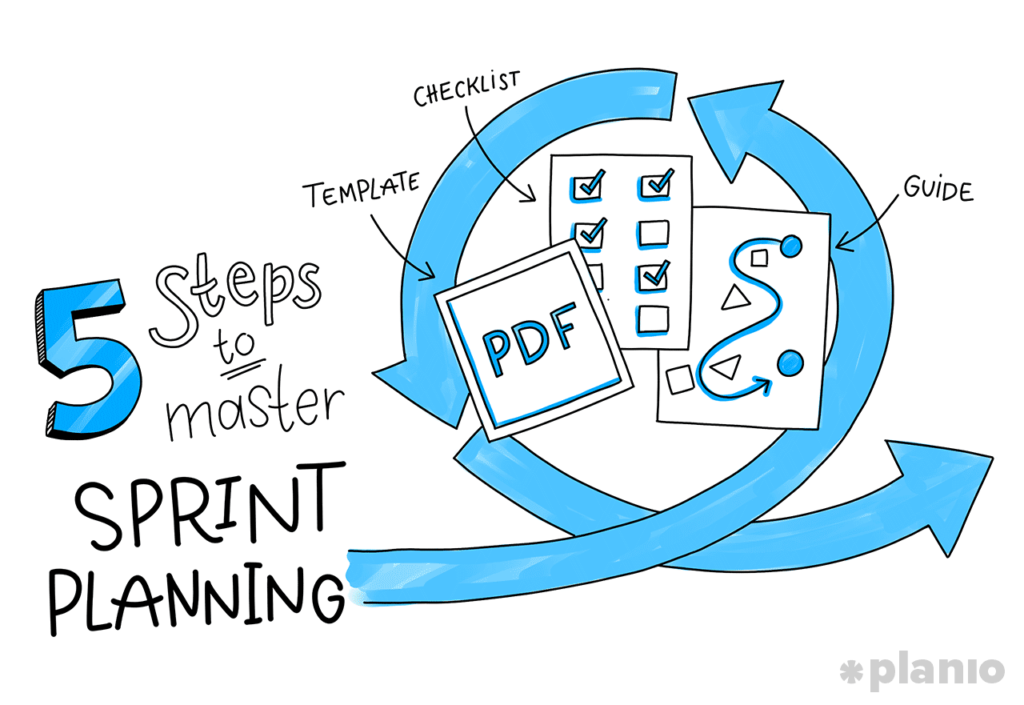
Managing Changes during Sprint
Handling Changes during Sprint
In project management, changes are inevitable, even during a sprint. It is essential for the team to manage changes effectively while minimizing disruptions to the sprint’s progress. Here are some best practices for handling changes during a sprint:
-
Open Communication: Maintain open lines of communication among team members, stakeholders, and project sponsors. Encourage regular updates, feedback, and discussions to ensure that changes are communicated and understood by all relevant parties.
-
Evaluate Impact: Assess the impact of proposed changes on the sprint goal, timeline, and resources. Consider the potential risks, resource constraints, and dependencies before deciding to incorporate the changes into the sprint.
-
Prioritize Changes: Prioritize changes based on their impact and alignment with the sprint goal. Collaboratively evaluate the urgency and significance of each change, ensuring that the most valuable changes are prioritized while minimizing disruptions to ongoing work.
-
Manage the Sprint Backlog: If changes are accepted during the sprint, review and adjust the sprint backlog accordingly. Assess the feasibility of accommodating the changes and reallocate tasks or priorities as needed. Communicate these changes to the team to ensure everyone remains informed and aligned with the revised sprint plan.
Impact of Changes on Sprint Progress
Changes during a sprint can have varying impacts on the sprint progress, depending on the nature, timing, and scope of the changes. Some potential impacts include:
-
Schedule Delays: Changes that require significant adjustments to tasks or additional work may lead to schedule delays, especially if the sprint timeline is fixed.
-
Effort Redistribution: Incorporating changes may require reallocating resources or reprioritizing tasks in the sprint backlog. This can impact the workload and effort estimates, potentially affecting the completion of other tasks.
-
Scope Creep: Uncontrolled changes can result in scope creep, where the project’s scope expands beyond its initial boundaries. This can strain resources, impact the ability to complete tasks within the sprint, and potentially compromise the sprint goal.
To mitigate the impact of changes, it is crucial to properly manage and prioritize changes, maintain effective communication, and regularly reassess the sprint backlog to ensure alignment with the revised project requirements.
Sprint Metrics and Reporting
Tracking Sprint Progress
Tracking sprint progress is essential to ensure the timely delivery of project objectives and to identify areas for improvement. Here are some key considerations for effectively tracking sprint progress:
-
Task Completion: Monitor the completion of tasks within the sprint backlog to evaluate progress. Identify any tasks that are falling behind schedule and take proactive measures to address them.
-
Burndown Chart: A burndown chart visually represents the remaining work versus the planned work over time. It provides a snapshot of the team’s progress and helps identify if the sprint is on track or if adjustments are needed.
-
Velocity: Velocity measures the amount of work completed by the team in each sprint. It provides insights into the team’s productivity and serves as a useful metric for planning future sprints.
-
Quality Metrics: Assess the quality of the deliverables by tracking metrics such as customer satisfaction, defect density, or the number of escaped defects. This helps maintain high standards and ensures that the sprint deliverables meet the required quality criteria.
Common Sprint Metrics
Several metrics can be used to measure and evaluate sprint performance. Some common sprint metrics include:
-
Velocity: Velocity measures the average amount of work the team can complete in a sprint. It provides a basis for predicting the team’s capacity and helps in sprint planning.
-
Sprint Burnup: The sprint burnup chart illustrates the cumulative work completed against the planned work over time. It allows for visualizing progress and comparing it with the ideal trend.
-
Work Item Age: This metric tracks the age of work items in the sprint backlog. It helps identify items that have been pending for an extended period and signals potential bottlenecks or issues.
-
Blocked Time: Measuring the amount of time team members spend on blocked tasks provides insights into obstacles or dependencies that hinder progress. Addressing these issues promptly can improve efficiency and productivity.
Generating Sprint Reports
Sprint reports serve as a means of communication and reporting progress to stakeholders. By providing a summary of completed tasks, goals achieved, and metrics, sprint reports contribute to transparency and accountability. Some key elements to include in a sprint report are:
-
Sprint Goal: Start the report by restating the sprint goal and the overarching objectives the team aimed to achieve.
-
Completed Tasks: Highlight the tasks or user stories that were successfully completed during the sprint. This demonstrates the value delivered and progress made.
-
Outstanding Tasks: Identify any tasks that were not completed within the sprint and explain the reasons behind their partial or Non-completion.
-
Metrics and Performance: Include relevant metrics, such as velocity, burndown chart, or quality metrics, to showcase the team’s performance and progress.
-
Issues and Risks: Outline any issues, impediments, or risks that were encountered during the sprint. Briefly describe the actions taken to address them and any impact they may have had on the sprint’s progress.
-
Lessons Learned: Provide insights and lessons learned from the sprint. Reflect on what went well, what could be improved, and any adjustments made for future sprints.
Sprint reports should be concise and informative, allowing stakeholders to assess the progress and make informed decisions regarding the project.
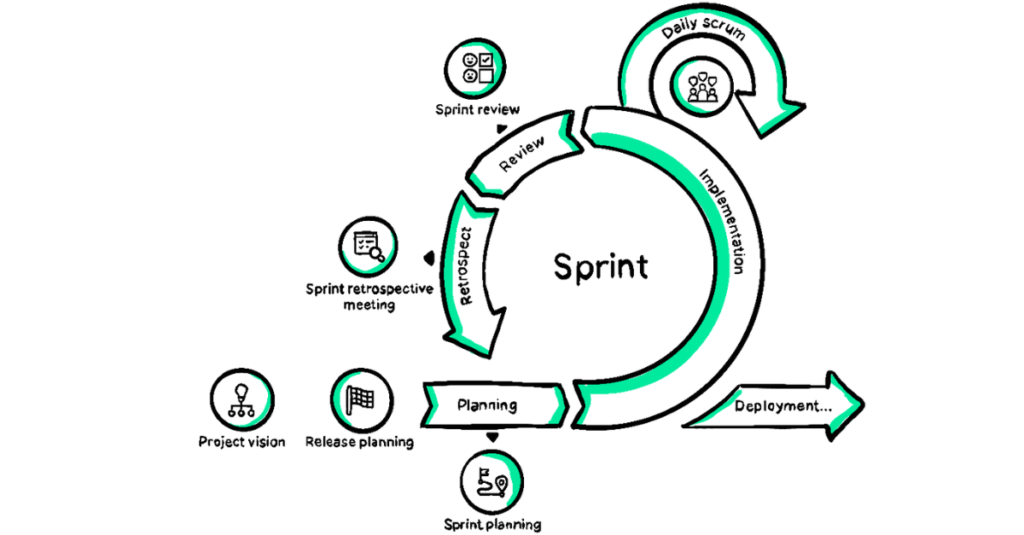
Best Practices for Successful Sprints
Clear Sprint Goals and Objectives
Ensure that your sprint goals and objectives are well-defined and aligned with the overall project objectives. Clear goals provide clarity and focus, enabling the team to prioritize tasks effectively and work towards a common purpose.
Effective Communication and Collaboration
Promote an environment of effective communication and collaboration within the team. Encourage regular and open communication, foster trust and respect among team members, and utilize collaboration tools and techniques to facilitate seamless coordination.
Continuous Improvement and Adaptation
Adopt a mindset of continuous improvement and adaptation. Encourage the team to regularly assess their processes, reflect on their performance, and implement iterative enhancements to optimize their efficiency and effectiveness.
Challenges and Solutions in Sprint Management
Common Challenges in Sprint Management
Sprint management can present several challenges that may impede the successful execution of sprints. Some common challenges include:
-
Scope Creep: Project requirements may change or expand during the sprint, leading to scope creep. This can affect the team’s ability to complete tasks within the sprint timeline.
-
Unrealistic Expectations: Setting unrealistic expectations or timeframes can put pressure on the team and compromise the quality of deliverables. It is essential to manage stakeholders’ expectations and ensure realistic agreements are in place.
-
Lack of Prioritization: Poor prioritization can result in unclear goals and unfocused efforts. It is crucial to prioritize tasks based on their value and impact on the sprint goal.
Addressing Sprint Management Challenges
-
Change Management: Establish a robust change management process to manage changes effectively. Clearly define the process for evaluating and incorporating changes, and communicate any changes transparently to the team and stakeholders.
-
Continuous Stakeholder Engagement: Regularly engage with stakeholders to manage expectations and gather feedback. Maintain open lines of communication to address any concerns and ensure alignment throughout the sprint.
-
Effective Prioritization: Collaboratively prioritize tasks based on their value, impact, and dependencies. Ensure that the team has a clear understanding of the sprint goal and how each task contributes to its achievement.
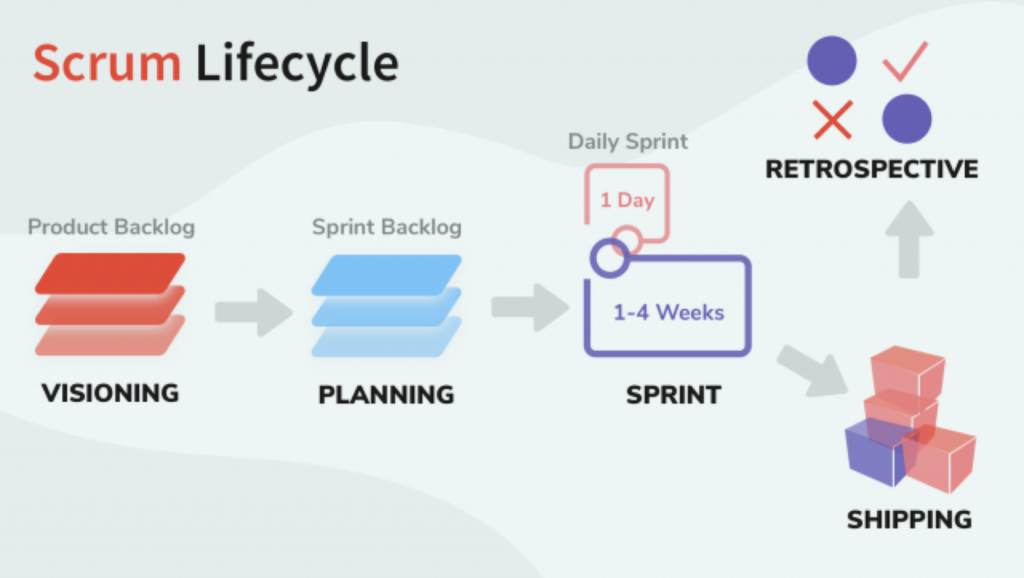
Sprint in Different Project Management Methodologies
Sprint in Agile Project Management
Sprints are integral to agile project management methodologies, allowing for iterative and incremental development. Agile methodologies, such as Scrum, focus on delivering value to customers through frequent releases of working software. Sprints serve as the time-boxed cadence for planning, executing, and reviewing iterations of development.
Sprint in Scrum
Scrum is a popular agile project management framework that utilizes sprints as its primary unit of work. In Scrum, sprints typically last two to four weeks and involve activities such as sprint planning, daily stand-ups, sprint review, and retrospective. Scrum teams work collaboratively to deliver a potentially shippable increment of the product by the end of each sprint.
Sprint in Kanban
Kanban, another agile project management methodology, uses a continuous flow approach rather than fixed-length sprints. However, Kanban can still incorporate concepts of sprints by defining a time-bound period, often referred to as a “cadence,” during which specific work is focused on and completed. Kanban cadences help teams maintain a predictable rhythm of work and facilitate planning and review activities.
Conclusion
Sprints play a vital role in project management, particularly in agile methodologies. By breaking down large projects into manageable chunks, sprints promote focused effort, regular feedback, and continuous improvement. Effective sprint planning, execution, and review contribute to successful project outcomes and foster a collaborative and adaptable work environment. By understanding the purpose, key components, and best practices of sprints, project managers can maximize their effectiveness and achieve project objectives efficiently.
